Beets are well worth the effort if you’re looking for a tasty, low-calorie, and highly nutritious addition to any meal. The problem is that working with this root veggie can get messy.
Most beet varieties come in a deep blood-red color, which tends to stain everything it touches.
I’m a beet lover and had to learn this the hard way while cooking professionally in numerous vegetable-friendly kitchens. Fortunately, when you prep beets again and again, as we did, it doesn’t take long to learn the secret tricks of the trade.
In this article, I’ll share some great ways to cook, peel, and store beets. You’ll also learn a few handy tricks on how to keep the mess manageable and how to select the best beets from the produce bin.
In This Article
The Absolute Easiest Way to Peel and Prepare Beets
There are a number of great ways to prepare beets, but roasting is my absolute favorite.
If you follow this method, your beets will turn out incredibly rich and delicious. Theyll also stay completely intact and won’t have their flavor diluted in water.
Importantly, roasting makes for no-fuss peeling with a low risk of staining.
Here’s how to do it,
First, Remove any greens
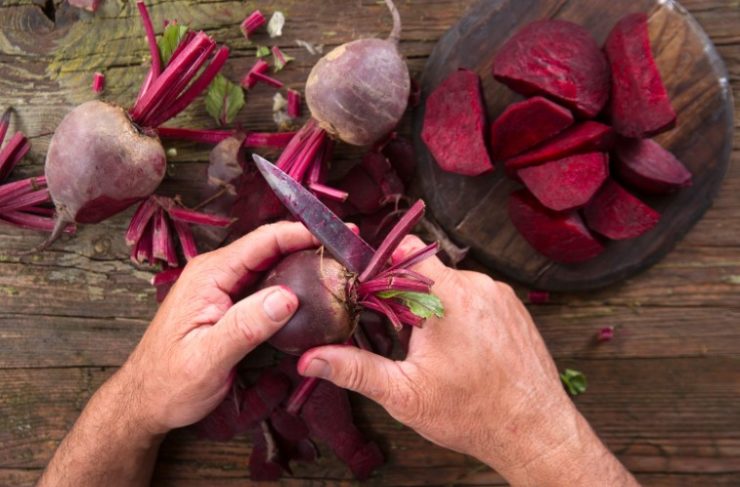
Cut the green leafy tops off of your beets if they are attached. Save them to cook separately. They can be added to soups or lightly wilted like spinach greens with your seasonings of choice.
Seal beets in aluminum foil

Place a sheet of aluminum foil in the pan and place beets on top, clustered together.
Drizzle a little olive oil over your beets before sealing up the foil to add extra flavor and richness.
Seal up the aluminum foil completely to keep all steam and juices inside during the roasting process.

Alternatively, the beets can be roasted with water. Place them in a roasting pan or Dutch oven with about a half-inch of water. Use a tightly-fitting lid or aluminum foil over the pan, sealed well to keep the steam inside, and bake as directed.
Roast in a hot oven
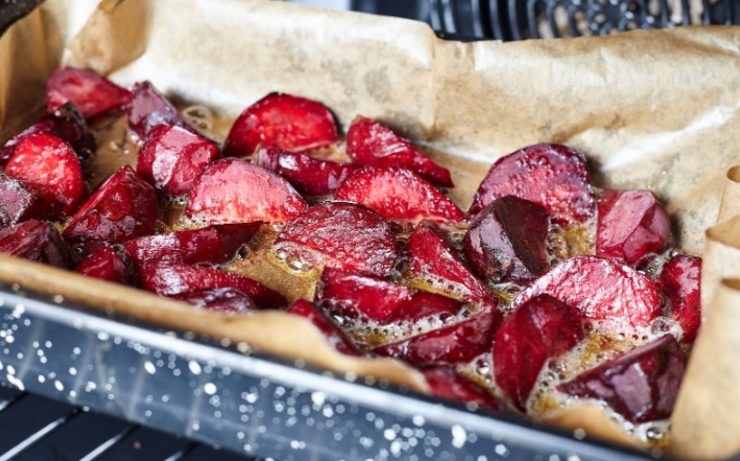
Preheat your oven to 425 degrees F. Roast beets for 20-50 minutes, checking tenderness periodically with a fork or paring knife.
Remove the beets when they’re cooked through.
Once a paring knife or fork slides easily into the beets, they’re ready to remove from the oven.
Cool and Remove The Skin
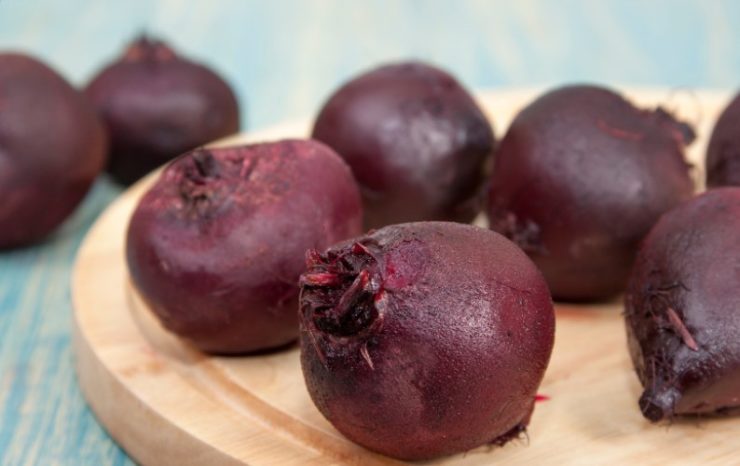
Before peeling your beets, let them cool to a comfortable temperature for handling. Handling before they’re ready is an easy way to get a burn. Believe me, steam is hot!
Ideally, cooling should take about 15-25 minutes.
Once cooled, wet your hands with water or fill a bowl with water. This will help to prevent staining.
Massage the skin off the beet with wet hands, or while holding the beet underwater. It should slide right off.

For any stubborn skin that doesn’t rub off, carefully use a paring knife to remove it.
Chop to desired size and shape
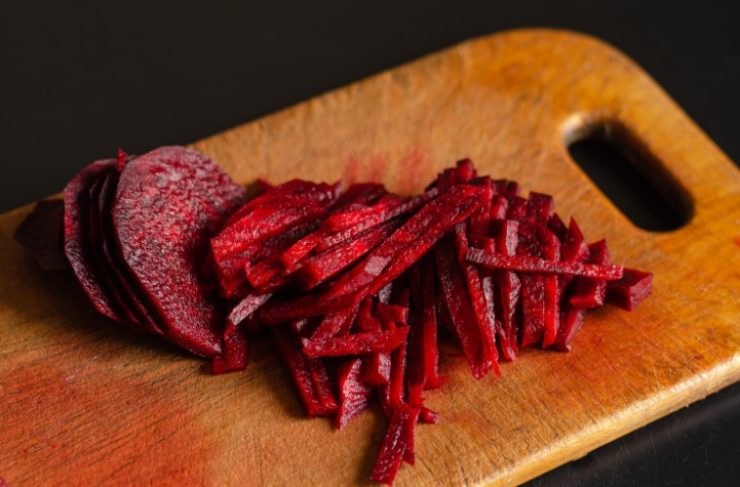
Depending on what you’re making, your beets can be diced, cut into strips, or even cut super small as part of a relish or topping.
Check out our beginner’s guide to the basic knife cuts to find fun ideas, and build your knife skills.
Serve them up!

Roasted beets can be served as-is like a side dish.
Toss them with a little apple cider vinegar and salt and pepper for a zingy accompaniment, or add them to a salad or healthy “bowl” type dish.
They can also be puréed and added to soups.
How To Avoid Beet Stains
Before cutting your beets, be sure to choose a cutting board that you don’t mind getting stained. Plastic cutting boards are preferable if you have one.
For peeling boiled, roasted, or steamed beets, you have three primary options to avoid staining your hands:
Wet your hands
My favorite option is to simply get your hands wet before handling the beets, then wash your hands right after. It works like a charm. (Keep in mind this may not work as well with very dry or cracked hands.)
Wear gloves
This option is also ideal for raw beets.
Use a paper towel
Use a paper towel to rub off the skin, shielding your hands from the juice.
Best Tools For The Job
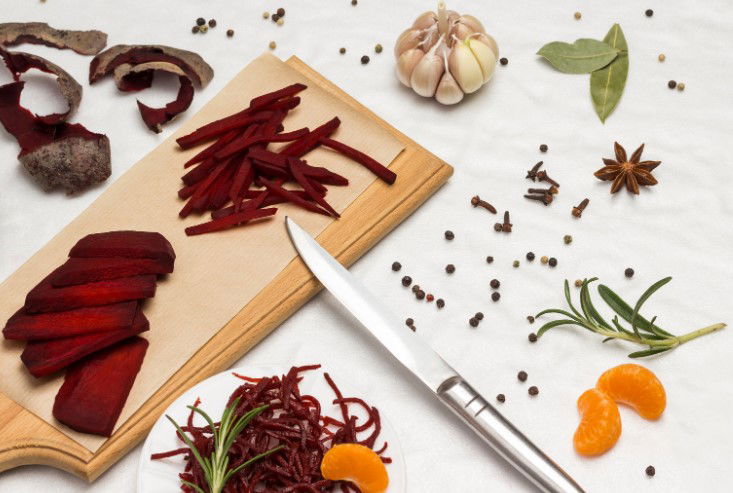
There aren’t a ton of tools needed to get this job done, but it’s important that the ones you do need are the right ones. Let me explain.
Chef Knife
Start with a sturdy, sharp chef knife.
Remember a sharp knife is a safe knife. This is because if you’re forcing your cuts with a dull knife it’s more likely to slip and catch you in a bad way.
Raw beets are especially tough, so try sharpening your blade if it’s been a while.
Cutting Board
Ok, so maybe this one is obvious.
If you’re using a sharp knife, you probably don’t want to mark up your countertop in the process. Also, depending on the countertop material you may risk chipping or bending the tip of your knife.
A cutting board is always better.
While I like working with a wood cutting board, it’s worth noting that plastic can be easier to remove stains from than wood.
Paring Knife (optional)
It’s not absolutely essential that you have a paring knife for this job, but I do find it helpful.
You can get a great one for under $35 that will last a decade (or more), and it will really help with the more delicate or detailed tasks where a full-size chef knife simply feels like overkill.
For roasted beets, a paring knife can be especially handy for checking “done-ness” and removing any stubborn little bits of peel that otherwise don’t want to let go.
Other Items
Most of the following are self-explanatory or optional, so I’ll spare you extended reasoning about why they’re useful. Some of these items are handy if you’re peeling without roasting, which I’ll explain momentarily.
- Aluminum foil
- Roasting or baking pan for oven roasting
- Saucepan with lid for boiling beets
- Steamer basket for steaming beets
- Latex gloves
- Paper towels
Dealing With Stains
Even if you’ve done your best to avoid beet stains, don’t get down on yourself when they happen. To be honest, it’s just part of cooking with the beetroot.
The most likely areas to catch a beet’s ruby-red color are your hands and your cutting board.
If you walk away from beet prep with stained hands the best remedy is to rub the stained areas with lemon juice, then wash hands with soap and water.
If you’re dealing with a stained cutting board, you can rub it down with salt and then wash as you normally would with a little soap and water.
A Few Other Beet Prep Methods
Boiling or Steaming

These are two other ways that you can wait to peel your beets until after they’re cooked, which is always easier. Just boil or steam your whole beets until they’re fork-tender. Then let them cool a bit and rub the skins off with wet hands.
Raw
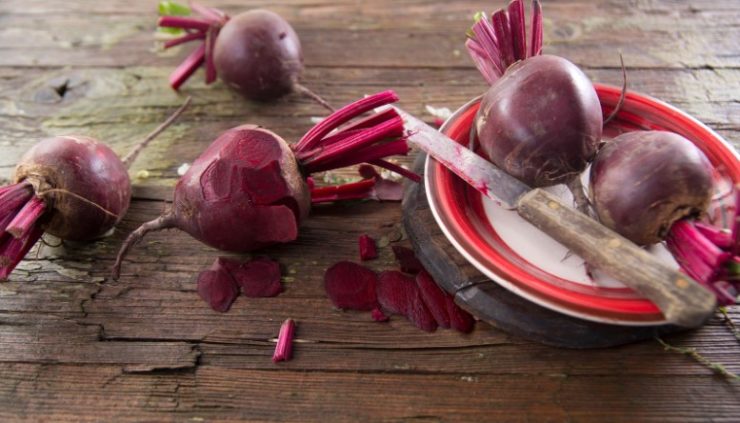
To use raw beets in a salad, for juicing, or to prepare beets to add to borscht soup, you’ll need to peel them while they’re raw. For this, it’s easiest to wear a pair of gloves.
Hold the beet firmly and use a vegetable peeler to remove the skin, peeling away from you. You may also need to cut off the taproot and the rough part of the beet where the greens were attached.
Once peeled, raw beets are easiest to dice or shred. Dice them to be cooked in soups, or shred or grate them for salads. Try adding them to homemade veggie burger mixes for extra flavor and texture. They can also be cut into wedges for easy juicing.
Leave The Peel In Tact
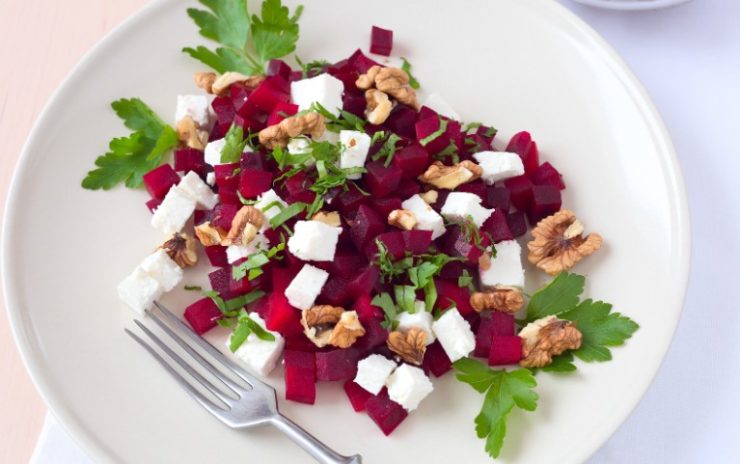
The appearance of your cooked beets is of course a matter of personal preference.
It’s perfectly okay to leave the peel on beets if you dice them before cooking, especially if the beets are younger. This may also add additional nutrients and texture to your dish.
Make sure you cut off tap roots and the stem area, however, as they can be tough.
Tips for Storage and Prep
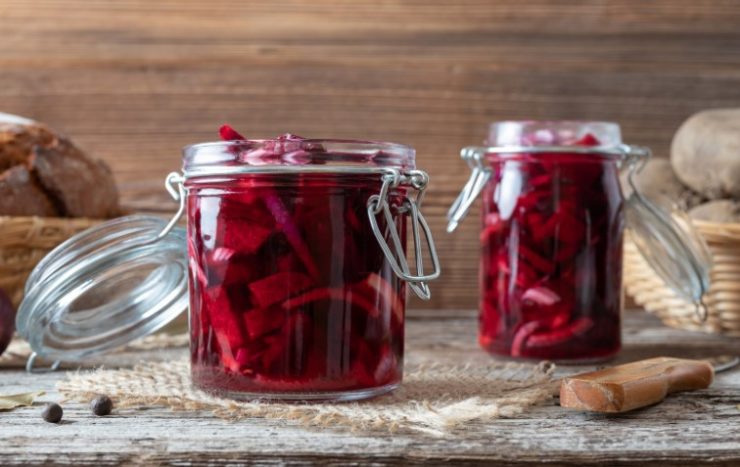
Raw Beets
Store whole raw beets in the crisper drawer of your fridge, either without a bag or in a paper bag. They can last up to two weeks, but the fresher they are when you cook them, the better.
Beet Tops
Beet greens can be stored after removal in a plastic bag, wrapped tightly in the fridge. The greens will last for 2-3 days, so ideally you’ll want to cook them up shortly after removing them.
Cooked Beets
Cooked beets (whether cut or whole) are best stored in an airtight container in the fridge. They should last at least 5 days, if not longer. They can also be frozen in an airtight container for several months.
Knowing now that you can save yourself the extra effort by cooking your beets before peeling them, the sky is the limit in terms of how you can serve them or include them in your favorite recipes.
Picking Out the Best Beets

The best way to tell if your beets are fresh is whether they still have the greens attached. It’s more difficult to tell how fresh beets are when the greens have already been removed. Additionally, the greens are fully edible and nutritious.
If you can’t find beets that still have the leaves attached, that’s okay, too. Inspect them to make sure they don’t have any slimy spots or big cracks in the base (where the greens were cut off). They should feel very firm and not have any wrinkles on their skin.

For size selection, go for beets that aren’t too much bigger than a tennis ball, if possible. The larger beets are, the less flavor they tend to have.

How to Cook and Peel Beets
- Total Time: 40 minutes
- Yield: Varies
Description
Cook and peel beets easily to add to soups, sides, salads, and beyond.
Ingredients
- Beets
Instructions
- Remove greens
- Preheat oven to 425 F.
- Place beets on a roasting pan or sheet tray and wrap and seal well with aluminum foil.
- Roast beets for 20-50 minutes until fork-tender.
- Remove beets when cooked through.
- Let cool until ready to handle, about 15 minutes.
- Wet hands and rub the skin off with fingers. Remove any stubborn skin with a paring knife.
- Cut to your desired size and shape.
- Serve or store as desired.
Notes
This same method of rubbing to remove the beet skin once cooked can also be used after boiling or steaming whole beets.
- Prep Time: 40 minutes
- Category: Knife Skills
- Cuisine: Any
Keywords: how to peel beets, how to skin beets, how to roast beets









